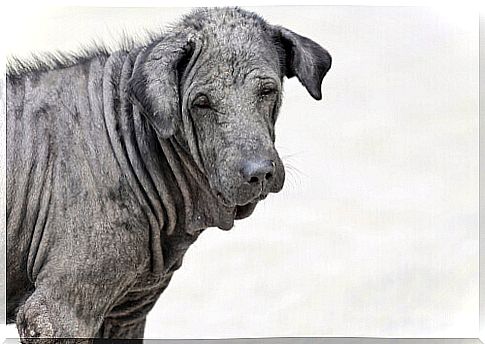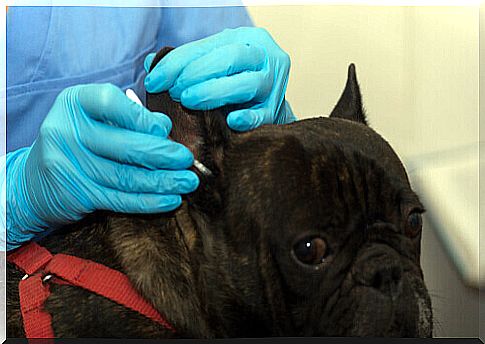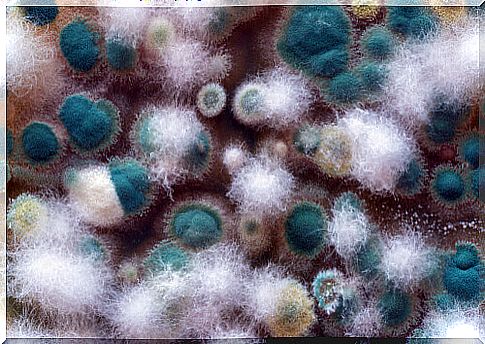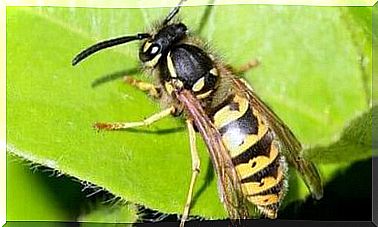Fungal Infections In Cats And Dogs: What Are They?

Fungal infections in cats and dogs are an ever-increasing health problem for several reasons. First of all, they are infections that are impossible to eradicate because fungi live in the same environment that our dogs frequent.
These types of infections also affect men, but usually develop in individuals with an undeveloped or very weak immune system. For this reason, we speak of zoonotic diseases or zoonoses.
These fungal infections not only affect the skin, but can affect other organs such as those of the respiratory system. Finally, preventing, diagnosing and treating fungal infections is very difficult.
Types of fungal infections in cats and dogs
Fungal infections in cats and dogs don’t just affect the dermis or epidermal tissue. Depending on the fungal species they can also occur in other parts of the body. In many cases, complete recovery without relapse is very difficult.
Dermatophytosis
Dermatophytosis can affect both dogs and cats. In both cases, the responsible fungus is Microsporum canis . This fungus is the cause of fungal infections in over 90% of dogs and cats. Furthermore, it is the one that most infects humans.

Cryptococcosis
Cryptococcosis is a disease caused by the fungi Cryptococcus neoformans and Cryptococcus catsi . It is more common for cats than for dogs. This is because, typically, these fungi bind to the feline immunodeficiency virus. Cryptococcosis affects the eyes, respiratory system, lymph nodes, skin, subcutaneous tissue and the central nervous system.
Fungal infection in cats and dogs: mycotic rhinitis
Fungal rhinitis, which only affects dogs, is caused by fungi of the genus Conidiobolus . The only symptom is an intermittent discharge of material from the nostrils. It can be mistaken for a tumor, therefore, a differential diagnosis is needed.
If not diagnosed in time, this fungal infection can destroy the nasal turbinates and penetrate the sinuses. This would cause the dog to die because the infection would affect several organs and the central nervous system.
Systemic mycosis
It is caused by fungi of the genus Aspergillus . In dogs, this disease is being studied. It is not yet known how the fungus can enter the animal’s body, but the infection is probably believed to be transmitted through wounds.
Generally, it is a chronic disease whose symptoms do not appear before three years after infection. It can affect any organ in the body and even bones.
Otomycosis
In dogs, otomycosis is treatable in 90% of cases. For the remaining 10%, unfortunately, the disease becomes chronic. This otitis is caused by yeasts of the genus Malassezia . Usually, it is treated with anti-inflammatory, antifungal, and antimicrobial drugs.

How can we recognize fungal infections in cats and dogs?
If you suspect your pet may have a fungal infection, we recommend that you take him to the vet as soon as possible. Typically, fungal infections are very annoying and, at times, very dangerous.
There are various ways to diagnose a fungal infection in dogs and cats. Your vet will decide which is most effective for your pet.
- Wood’s lamp. This device uses ultraviolet light to detect fungi on your pet’s skin. To use Wood’s lamp correctly, you need to leave it on for 5-10 minutes so that the wavelength of the light stabilizes. In addition, any lesions on the animal’s skin that we suspect may be fungal infections should be exposed to light for another five minutes.
- Direct examination. Samples of skin and hair are taken (by scraping) or samples inside the ear (by means of a swab) and are observed under the microscope after having colored them.
- Culture. Samples are taken of various tissues and fluids that are thought to be infected. After that, they place themselves in different culture media and wait to see if some kind of fungus develops or not. If the fungus cannot be identified through the microscope, a polymerase chain reaction (PCR) is performed to determine its species.

How are mushrooms transmitted?
As mentioned earlier, many of these fungal infections can also be transmitted to humans from animals that do not exhibit clinical symptoms. Therefore, it is very important to have your pets examined regularly by a veterinarian.
Infectious agents can be transmitted in various ways:
- Direct contact with the sick animal without taking note of the correct prophylaxis.
- Direct ingestion of the pathogen.
- Inhalation. Very common in bird fungi, which usually originate from the digestive tract and develop in the faeces. Contagion is difficult unless the cage is kept clean enough.
- Intermediate vectors.
- Bites.









